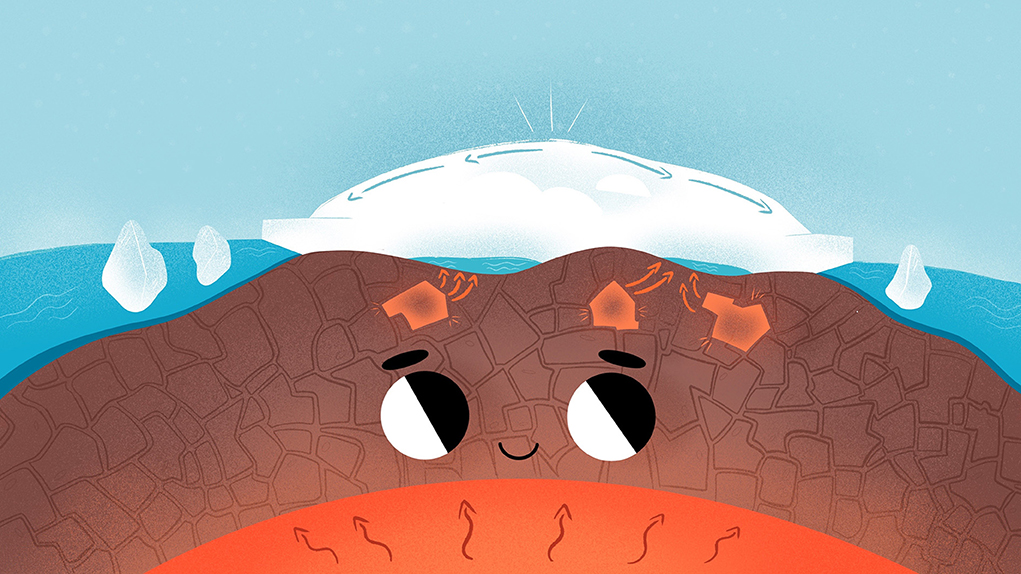Melting from below: explaining the complex nature of ice sheet dynamics and geology to kids and tweens

The article frames the abstract on ice sheet dynamics into understandable language and relatable problems. Image: ‘Geothermal Heat Shapes the Antarctic Ice Sheet From Below‘ in Frontiers for Young Minds.
There is a deep, unexplored landscape beneath the Antarctic ice sheet. Scientists must combine different research areas and skills to investigate the geology of this area and its effects on the ice sheets. This information is crucial to understand how Antarctica will respond to climate change.
In a recent Frontiers for Young Minds outreach article, a team of ACEAS researchers and collaborators, led by Dr Tobias Stål, explain why taking a closer look beneath Antarctica is essential. The ice sheet is shaped by geothermal heat—which remains a constant in the face of a changing climate.
Distilling the complex into everyday language
The journal is a platform for “young people and scientists to work together to create articles that are both top quality and exciting.” The paper provides young readers with a background on ice sheet dynamics. It frames those abstract ideas into understandable language and relatable problems: can we compare the ice sheets to chocolate, or geothermal heat to tea kettles?
“For example, the ice can stick and deform or slide smoothly across the land under the ice,” Dr Stål said.
“Naturally occurring heat from the inner Earth can cause the base of the ice sheet to melt and soften so that it flows more easily, sliding on the meltwater formed,” he said.
The challenges of studying geothermal heat
The amount of geothermal heat varies across Antarctica and is difficult to measure. Dr Stål said researchers only relatively recently realised just how important subglacial geothermal heat distribution was with ice sheet interaction. However, there are physical barriers to gaining new and comprehensive geothermal heat data.
“We cannot measure geothermal heat under the Antarctic ice sheets directly—it is far too challenging and expensive to drill through kilometres of ice into the sediments and rocks beneath to get a reliable value of geothermal heat,” Dr Stål said.
Several heat sources can contribute to melting the ice sheet from beneath.
“Geothermal heat varies on all scales, so we would need many measurements to get representative values,” he said.
Maps of geothermal heat distributions are used in ice sheet models. However, Dr Stål said, “There were no reliable maps of geothermal heat that the ice sheet modellers could use as input for their computer models.”
But, there’s more…
He explains geothermal heat is only a tiny fraction of the overall heat added to Antarctica’s ice shelves and glaciers. Warming ocean currents and a warming atmosphere cause melt along the coasts, on the surface, and at the base of ice shelves and glaciers.
“Here is where we see the impact of ongoing climate change,” he said. “However, to understand how the ice sheet responds to our warming climate, we also need to better understand the natural properties that impact how, where and at what rate the Antarctic ice sheet is changing.”
Preparing future generations for tomorrow
Dr Stål said he finds it difficult, but very important, to write for young readers.
“We need more scientists to collaborate as well as new generations of scientists with novel and refined ideas,” he said.
“The climate change we are causing will continue to impact their world when we are no longer around. We need to prepare them better for the challenges of tomorrow—it’s the least we can do.”
PAPER
Tobias Stål, Felicity S. McCormack, Anya M. Reading, Niam Askey-Doran, Jacqueline A. Halpin, Mareen Lösing. (2024). ‘Geothermal Heat Shapes the Antarctic Ice Sheet From Below’. Frontiers for Young Minds. DOI: 10.3389/frym.2023.1178537
